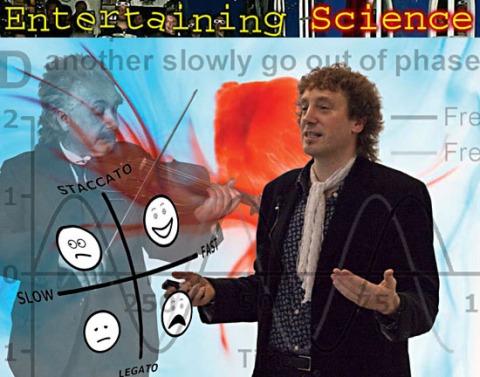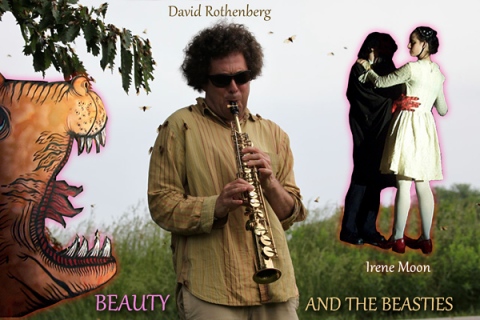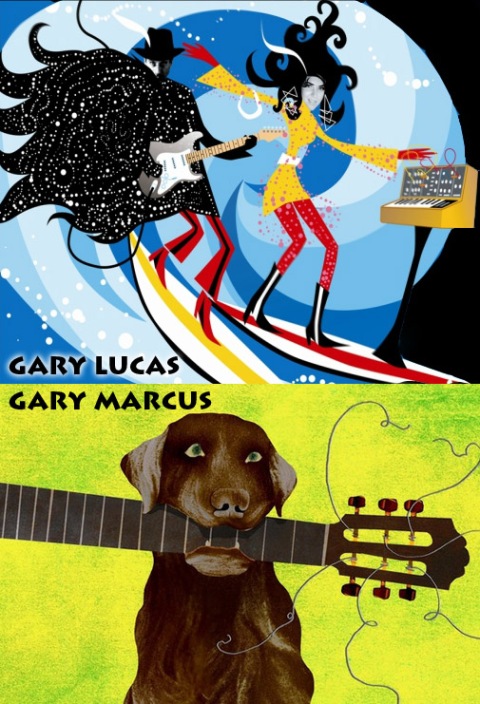FLIGHT CLUB
December 9, 2012 § Leave a comment

Birds own the air, and, tonight, the Cornelia Street Café. Many birds migrating at night give unique calls that are often less than 1/3 of a second and with distinct spectral patterns.
Andrew Farnsworth, who studies bird migration at Cornell’s Laboratory of Ornithology, records and interprets these sounds, the only reliable way to track the species migrating at night. Hear of the powerful possibilities this affords for monitoring populations of birds, forecasting bird migration, and simply enjoying an incredible unseen phenomenon of hemispheric magnitude!
Anna Lindemann combines animation, music, video, and performance to explore the emerging field of Evo Devo (Evolutionary Developmental Biology). In her Theory of Flight, a scientist’s biology lecture on flight goes awry when she reveals her own extreme experiments. Dreams of flight, avian arias, a magical chalkboard, transgenic experiments, animated cellular processes, orchestral bird songs, and molecular music intersect in this emotional and scientific pursuit of human flight.
YOU ARE WHAT YOU HEAR
November 11, 2012 § Leave a comment

Why do we have music, and what does it do to us? Psychobiologist Harry Witchel reveals the answers. He will relate the science of music to humorous anecdotes from the history of pop culture, to unveil why music makes us feel so good — or why the wrong music makes us feel so bad. He will be joined by cellist Raul Rothblatt (fresh from his gig with the New York Philharmonic) who demonstrates the power that music has.
Dr. Harry Witchel is Discipline Leader in Physiology at the Brighton and Sussex Medical School in the UK.
Raul Rothblatt is a cellist and composer, who has three bands: Kakande, Életfa , and Dallam-Dougou.
IT YEAST AIN’T THE SAME
October 14, 2012 § Leave a comment
Who ever thought that lowly yeasts would matter so much to us? Or tell us so much about ourselves? Please join us as we decant wines and debunk their hooey with scientific proof and practical examples of yeast and its magical properties. Peter Seidman, a certified sommelier, will enlighten us on what yeasts do for fermentation in making wine — biodynamic, organic, and otherwise. Viva intoxicating beverages! In measure; there will be tasting, so you can tell the difference. Meanwhile, hailing from a few miles west, Ethan Perlstein at Princeton – check out his award-winning mod website – introduces small molecules, including therapeutic drugs (like antidepressants), into simple model organisms such as the budding yeast Saccharomyces cerevisiae (now there’s a mouthful!) and studies the impact on their physiology. Perlstein works at the intersection of cell biology, personalized medicine and quantitative evolutionary theory – shaping a cross-disciplinary perspective he calls evolutionary pharmacology. Amazingly, evolutionarily conserved aspects of human diseases (e.g., schizophrenia and diabetes) get revealed to sober researchers.
HEARTS AND DEVILS
September 9, 2012 § Leave a comment
Our program this month brings together a leading researcher on addictive behavior with a songwriter and singer addicted to making music. Music draws us in, gives us a spiritual high, and so does science. But is that just loose talk, or does our dependence on music –those earbuds!– have a kinship to much more destructive substance abuse?
Come hear Carl Hart from Columbia University talk of his forthcoming book and his work on methamphetamine. Dorian Devins comes to us from, of course, Hell’s Kitchen – hear her every Friday at the Linc on W. 42nd — to bring us her remarkable new jazz songs. She will feature music from her forthcoming album, The Procrastinator.
PAY ATTENTION!
June 10, 2012 § Leave a comment

Even your brain doesn’t have the capacity to process everything in the environment simultaneously! The brain’s solution to this problem is to select from the environment things to process, and to filter out other things, so as not to waste brain energy on them. This filtering process is called attention.
Michael E. Goldberg, David Mahoney Professor of Brain and Behavior at Columbia University, and Ellen K. Levy, an artist and educator at the Institute for Doctoral Studies in the Visual Arts who has long visualized interconnections between art and scientific investigations, will describe the art and science of attention – how the brain organizes attention and how the artist uses it to shape what the viewer looks at and thinks about.
Goldberg will explore the trajectory of his original experiments on the cerebral cortex demonstrating how the brain creates a priority map of the world by integrating topdown and bottom up signals. Levy will expand on their collaboration, which led her to conduct a mischievous experiment, involving inattention blindness and 3-Card Monte in several galleries that functioned as atypical ‘laboratories’ for exploring the realm of human behavior.
RHAPSODY FOR PIANO AND UNIVERSE
May 13, 2012 § Leave a comment

So, a particle physicist and a singer-songwriter walk into a club in the West Village… and it’s no joke!
For at its heart, the physical world is a musical world. From the vibrations of a guitar string to the sunlight that sweeps away the dark, and even as far as the notorious Higgs boson, our universe is awash in waves.
Professor Matt Strassler, host of the website “Of Particular Significance”, and Andrea Wittgens, “silver-tongued” singer-songwriter-pianist, join forces to reflect on these notions from perspectives scientific, sonic and poetic.
They’ll sing us tales of the unknown, turn the volume down to the quantum level, shine photons on the mysterious particles of nature, and have fun doing it! And you’ll leave knowing why the grandest of all musical instruments is the universe itself.
LOOPS, WAVES AND TEXTURES
April 8, 2012 § Leave a comment

In the early 1970’s, John Adams began to write music that combined his interest in American popular music, the classics, and electronics. Inspired by the waveform transformation that occurs in a modulating circuit, Adams set out to write music “as if the piano was a generator of waveforms,” by using loops, phasing, and algorithmic devices. Pianist Jeff Lankov will perform Adams’ first exploration into minimalism, the revolutionary Phrygian Gates; as well as his “manic, bipolar scherzo,”American Berserk.
Waves are at the heart of what Ken Perlin does. Ken, who directs the NYU Games for Learning Institute, is an Academy Award winning computer scientist at NYU’s Media Research Laboratory who has created a goodly number of the techniques used in today’s cinema. His interests include animation with personality, realistic textures, and educational computer games. For this event, he will be creating original graphically animated work inspired by Jeff’s interpretation of John Adams’ music.
BEAUTY AND THE BEASTIES
March 11, 2012 § Leave a comment

David Rothenberg, author of WHY BIRDS SING and SURVIVAL OF THE BEAUTIFUL (“ecstatic” says the Wall St Journal, “triumphant” says the Guardian) will tell us why evolution is as much about survival of the beautiful as it is of the fittest; why Charles Darwin said the peacock’s tail made him sick. Showing us bowerbird sculptures and playing animal sounds from whales to cicadas, he explains why beauty is a necessary part of nature.
Which leads most naturally to a surreal performance by Irene Moon, of the Museum of Natural History and the Begonia Society, “What is Beautiful?”. In vignettes, biological organisms act out short PowerPoint plays emerging out of the creative fascination with detail that could only come out of the intimate relationship a scientist has with his or her subject. Song and imagery will make the disgusting beautiful – believe us. Moon’s actors include internal parasites–tapeworms, hookworms–and blood-sucking insects and their mouths–mosquitos, fleas, and, since this is New York City, bedbugs.
THE TWO GARYS–GUITAR ZERO & EXPONENTIAL
February 12, 2012 § Leave a comment

A tale of two Garys whose lives have intersected over a musical instrument.
Nearly all musical virtuosi and athletes learn the fundamentals of their crafts as children. As his 40th birthday approached, NYU psychology professor Gary Marcus decided to try to learn the guitar and investigate the science of how people become musical. He will contrast how musical understanding and skills are developed by children and adults, described in the new book, Guitar Zero.
Then a short concert by one of our great American guitar virtuosi, Gary Lucas. Gary cut his formidable chops with Captain Beefheart, leads the band Gods & Monsters, whose ranks once included Jeff Buckley with whom he co-wrote “Grace” and “Mojo Pin”, and is a Grammy-nominated songwriter and film and TV composer. He has carved out his own take on all the American guitar traditions from deep blues to Chet Atkins to Hendrix and Les Paul. He has an enormous repertoire, and many different instruments to choose from, so the music will be surprising, challenging, and beautiful.
SILENT GENES AND GENTLE SONGS
January 8, 2012 § Leave a comment

In 1955, physicist Richard Feynman complained that “the value of science remains unsung by singers: you are reduced to hearing not a song or poem, but an evening lecture about it.” What a difference a half a century makes!
Biochemist and classical guitarist John Olson will both talk of his research and perform music about science. John’s work at the Albert Einstein College of Medicine is on RNA interference, a recently-discovered means of silencing genes that has become a powerful new method for studying gene function — and shown promise as a new type of medicine.
The music, performed with John’s wife, actress, soprano and “recovering mathematician” Gioia De Cari, writer and performer of the hit solo show Truth Values: One Girl’s Romp Through M.I.T.’s Male Math Maze, will be taken from their Science/Music Commissioning Project, which seeks to explore and celebrate science through song.
The selections will include a set entitled “Men, Women, and Molecules” by composer Frank Wallace, based on the poetry of Roald Hoffmann. Selections by other composers will feature the writings of Albert Einstein, Linus Pauling, Marie Curie — and yes, Richard Feynman.
Join us for an evening of science, both spoken and sung
